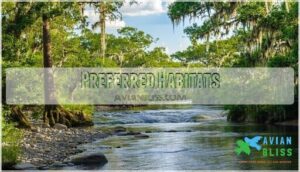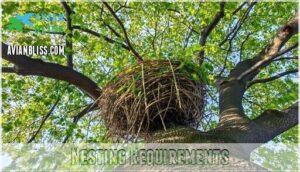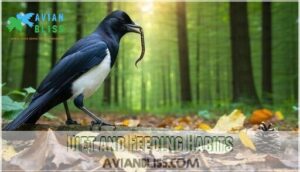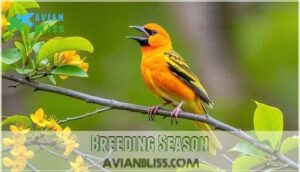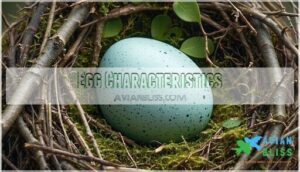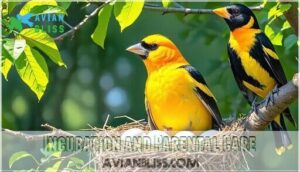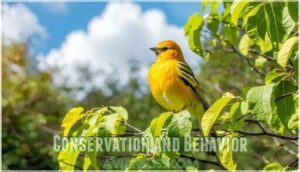This site is supported by our readers. We may earn a commission, at no cost to you, if you purchase through links.
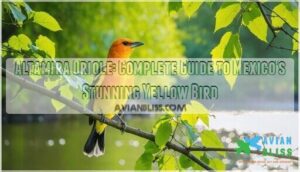
This vibrant bird sports brilliant orange-yellow plumage with black wings, throat, and tail—making it impossible to miss against green foliage.
Adults reach about 10 inches long with sturdy, pointed bills perfect for catching insects and sipping nectar.
They’re non-migratory residents who build incredible hanging basket nests from plant fibers.
Unlike their northern cousins, Altamira orioles stay put year-round, thriving in both wild woodlands and suburban areas with tall trees.
Their loud, flute-like songs carry far across their territory.
These remarkable architects create some of nature’s most impressive nesting masterpieces.
Table Of Contents
- Key Takeaways
- Altamira Oriole Overview
- Habitat and Distribution
- Diet and Feeding Habits
- Breeding and Nesting
- Conservation and Behavior
- Frequently Asked Questions (FAQs)
- What is the difference between Baltimore Orioles and Altamira Orioles?
- What do Altamira Orioles eat?
- What are some interesting facts about the Altamira Oriole?
- What do Altamira orioles eat?
- What are the characteristics of the Altamira Oriole?
- How long do Altamira Orioles typically live?
- Are there any predators specific to Altamira Orioles?
- How do climate changes affect Altamira Oriole populations?
- Can Altamira Orioles interbreed with other oriole species?
- What predators threaten Altamira Oriole nests?
- Conclusion
Key Takeaways
- You’ll spot North America’s largest oriole with its distinctive 10-inch frame, brilliant orange-yellow body, and contrasting black wings, throat, and tail that make identification straightforward.
- You can observe these birds year-round since they’re non-migratory residents who stay in their subtropical territories from Mexico through southern Texas, unlike other orioles that migrate seasonally.
- You’ll witness incredible nest architecture as females weave elaborate hanging pouches up to 26 inches long from plant fibers, creating some of nature’s most impressive suspended structures.
- You can attract them to your yard with hummingbird feeders filled with sugar water, since they maintain a diverse diet including insects, nectar, fruits, and readily visit backyard feeding stations.
Altamira Oriole Overview
You’ll recognize the Altamira Oriole by its impressive size and striking black-and-orange plumage that makes it the largest oriole in North America.
This remarkable bird combines vivid orange underparts with contrasting black wings, back, and throat, creating one of nature’s most eye-catching displays.
Physical Characteristics
When you spot an Altamira Oriole, you’ll notice its distinctive black head contrasting sharply with bright yellow underparts.
This largest oriole species displays striking color schemes with black plumage covering the beak shape, throat, and back.
The long beak pierces through dense foliage while hunting, and orange epaulets on wing structure create vibrant feather patterns.
Its identification becomes easier when observing the black tail length against yellow body plumage.
Size and Shape
You’ll immediately notice the Altamira Oriole’s impressive size among oriole species.
This largest member of genus Icterus measures approximately 25 centimeters in body length with substantial wing span proportions.
The bird weighs around 56 grams, giving it robust bird morphology.
Its beak shape appears sturdy and straight, perfect for varied feeding.
The head size proportionally matches its substantial frame, while tail feathers extend remarkably long.
These physical dimensions make bird size identification straightforward in the field, with the substantial frame and long tail feathers being key identifiers, and the overall size being a straightforward characteristic.
Plumage and Coloration
The Altamira Oriole displays stunning Color Patterns that make identification straightforward.
You’ll notice the striking contrast between bright orange underparts and jet-black upperparts. The black head extends down the throat, while Wing Bars appear as white fringes on dark flight feathers.
Orange Epaulets on the shoulders create distinctive patches. Adult plumage remains consistent between sexes, though juveniles show olive backs and brownish tones instead of pure black.
Measurements
You’ll find this New World oriole species measures consistently across populations.
The Altamira Oriole (Icterus gularis) ranks as the largest member within its bird taxonomy classification.
Here are the key measurements for this impressive bird species:
- Length Variations: Reaches approximately 25 cm (9.8 inches) from beak to tail
- Weight Factors: Adults typically weigh around 56 grams (2.0 ounces)
- Beak Measurements: Features a robust black mandible suited for varied feeding
- Wing Span: Displays broad wings with distinctive white fringe patterns
- Size Comparisons: Exceeds other New World orioles in overall body dimensions
Habitat and Distribution
You’ll find Altamira Orioles thriving in subtropical lowlands from Mexico’s Gulf Coast through northern Central America, with populations expanding into southern Texas since 1939.
These vibrant birds prefer open woodlands, semi-arid areas, and riparian zones where they can construct their distinctive hanging nests from horizontal tree branches or even telephone wires, using materials to create a unique hanging nests.
Preferred Habitats
You’ll discover these vibrant orioles thriving in subtropical lowlands and open woodland habitats across Mexico’s Gulf Coast.
They favor riparian zones along rivers where mesquite, hackberry, and cedar elm create perfect canopy cover.
Coastal habitats and woodland areas with scattered tall trees provide ideal foraging grounds, while subtropical regions offer the warm climate they need year-round.
The Altamira Oriole’s diet consists of various food sources, including those found at bird feeding stations.
Nesting Requirements
You’ll need to select specific nest placement locations for successful oriole nesting. These birds show particular preferences when constructing their elaborate woven structures.
Here are the key nesting requirements for Altamira Orioles:
- Tree Selection – Choose mature trees with sturdy horizontal branches extending 15-20 feet from the trunk
- Branch Length – Select branches at least 6 feet long to support the 2-foot hanging pouch nest
- Nest Placement – Position nests at branch tips for maximum protection from predators
- Nest Materials – Provide access to Spanish moss, palm fibers, grass, and bark strips for construction
- Nest Depth – Allow space for pouches reaching 26 inches in length with proper ventilation
Regional Subspecies
Currently, scientists don’t recognize distinct subspecies of Icterus gularis, though Geographic Variation exists across its range from the Mexican Gulf Coast through northeastern Mexico to southern Texas.
Regional Adaptation appears minimal, with populations showing consistent plumage and size.
However, Genetic Diversity studies suggest potential Subspecies Classification may emerge as researchers examine isolated populations more thoroughly.
Geographic Range
The Altamira Oriole’s geographic range stretches from southern Texas through Mexico’s Gulf Coast into northern Central America.
You’ll find these birds primarily along the Mexican Gulf Coast, northeastern Mexico, and the Rio Grande Valley.
Since 1939, range expansion has brought them into southern Texas, where they’ve established stable populations despite geographic isolation from their main North American distribution.
The species’ survival depends on preserving its natural habitat loss to maintain a stable population.
Diet and Feeding Habits
You’ll discover that Altamira Orioles maintain a remarkably diverse diet that changes with seasonal availability and habitat conditions.
These adaptable feeders consume everything from grasshoppers and caterpillars to sweet nectar and ripe fruits throughout their range.
Insects and Arthropods
Most protein-packed insects fuel your oriole’s energy needs throughout the year.
These birds excel at insect foraging, targeting grasshoppers and crickets during peak abundance.
Their caterpillar preferences shift seasonally as larvae emerge.
Spider consumption provides essential amino acids, while ant predation occurs opportunistically.
Seasonal variations affect insect availability, making these arthropods important dietary components for successful reproduction and survival.
Understanding proper insect food sources is essential for maintaining a healthy oriole population.
Fruits and Nectar
Sweetness drives these birds’ passion for nature’s candy.
You’ll find Altamira Orioles savoring hackberries and figs as primary fruit sources.
They pierce nectar-rich flowers like masters, extracting sugar from tubular blooms.
Berry consumption includes mulberries and native varieties from fruit-bearing plants.
Their bills work perfectly for accessing nectar types that fuel migration and breeding energy needs, especially for sugar.
Feeding at Feeders
You’ll attract Altamira Orioles to your yard with the right feeder setup.
These birds enthusiastically visit hummingbird feeders filled with sugar water solutions, preferring 1:4 sugar-to-water ratios.
Orange-colored nectar feeders work best since they mimic natural nectar-rich flowers.
Position backyard feeders near trees where they typically forage, and you’ll soon witness their feeding behavior firsthand.
Understanding proper hummingbird feeder maintenance is essential for attracting these birds to your yard with the right setup.
Foraging Behavior
You’ll observe these birds using deliberate foraging techniques as they methodically search tree branches from canopy to undergrowth.
Their insectivorous diet drives them to examine leaves carefully for grasshoppers and caterpillars. These feeding strategies include puncturing flower bases for nectar consumption from nectar-rich flowers.
Wild foraging extends to berry consumption when available. Tree foraging remains their primary method, moving slowly through foliage with precision.
Understanding their ground feeding behaviors can provide insights into their foraging habits and ecosystem role, highlighting the importance of their insectivorous diet and tree foraging methods.
Breeding and Nesting
The Altamira Oriole’s breeding season runs from late April through July in Texas, when you’ll witness their remarkable nest-building skills.
These birds create extraordinary woven pouches up to 26 inches long that hang like natural masterpieces from tree branches.
Breeding Season
You’ll witness male Altamira Orioles perform elaborate courtship displays during their breeding season from late April through July.
These impressive mating rituals help establish pair bonds in their Texas habitat.
Here’s what characterizes their breeding habits:
- Males showcase vibrant orange plumage while singing complex songs
- Courtship displays include wing-spreading and tail-fanning behaviors
- Pairs remain monogamous throughout the breeding season
- Breeding territories average 0.25 kilometers apart with minimal aggression
Nest Construction
You’ll watch females craft remarkable woven pouches that stretch 14-26 inches long.
These nest construction masterpieces use plant fibers, grasses, and urban materials like string.
The weaving process takes 18-26 days as females hang upside down, tangling fibers with bills and feet.
Nest placement occurs at branch tips 10-36 feet high, creating pendulous structures with entrances at top and chambers below.
The use of nesting material sources is essential for the birds’ nest construction process, which relies on careful selection of materials to create a safe and cozy environment.
Egg Characteristics
Once the female completes her elaborate nest construction, she’ll lay her clutch of eggs that show remarkable consistency in their appearance and characteristics.
The meticulous female creates her architectural masterpiece with unwavering precision and remarkable consistency.
The eggs display specific traits that help identify this species.
Here are the key characteristics of Altamira Oriole eggs:
- Egg Color: The eggs are pale blue to green with darker speckles scattered across the shell surface
- Egg Shape: They maintain an oval shape typical of most oriole species in the genus Icterus
- Shell Thickness: The shells are relatively thin but durable enough to protect developing nestlings during incubation
- Yolk Size: The yolk provides adequate nutrition for the 12-14 day incubation period required for proper development
Incubation and Parental Care
During incubation, both parents actively share nest guardians duties for twelve to fourteen days.
The female primarily handles egg incubation while the male provides food and protection.
Once chicks hatch, parental care intensifies dramatically.
Both adults work tirelessly feeding nestlings insects and nectar every few minutes.
This dedicated chick rearing guarantees strong brood survival rates in their pouch-like nesting structures.
The Altamira Oriole’s nesting success is influenced by factors related to bird nesting habits, which affects their nesting success and overall breeding habits, ensuring the species’ survival.
Conservation and Behavior
You’ll discover that Altamira Orioles display fascinating non-migratory behavior patterns and maintain stable populations across their range.
Their interactions with humans range from backyard feeder visits to important ecological roles in their native habitats, showcasing their ecological significance.
Migration Patterns
You’ll find Altamira Orioles don’t follow typical migration patterns like other North American songbirds.
These tropical residents stay put year-round in their territories. Instead of seasonal movements along traditional flyways, they make short local dispersals based on food availability.
Young birds might wander further from natal areas, but adults rarely leave their established wintering grounds, which are actually permanent homes.
Conservation Status
You’ll find the Altamira Oriole currently holds a reassuring conservation status globally.
The IUCN Red List classifies this species as Least Concern, indicating stable populations across most of its range.
However, the picture varies by region:
- Global status: Least Concern with no immediate extinction risk
- Texas populations: Threatened with fewer than 500 breeding pairs
- Primary threats: Habitat loss from deforestation and urbanization
- Climate change: Drought and extreme weather reduce nesting sites
- Human impact: Development eliminates essential riparian woodlands
While habitat preservation efforts continue, regional species decline remains concerning despite overall population stability.
Population Trends
You’ll notice population trends for Altamira Orioles paint a complex picture of growth and decline.
Growth rates in Texas showed promise between 1950-1980 after the species first nested there in 1951.
However, recent decades reveal concerning population decline patterns.
Stable populations persist in Mexico and Central America, but Texas strongholds like Santa Ana face continued declines since the 1990s.
Habitat loss from development and drought remains the primary decline factor affecting bird population dynamics.
Conservation efforts focus on protecting remaining woodlands, though the stable population status outside the U.S. provides hope for the species’ long-term bird conservation status.
Human Interactions and Cultural Significance
Bird enthusiasts discover countless opportunities for wildlife education through observing Altamira Orioles in their natural habitat.
Eco tourism initiatives often feature these striking birds, promoting bird habitat protection across their range.
Urban development threatens traditional nesting sites, making bird conservation efforts essential.
Their vibrant plumage holds cultural symbolism in Mexican folklore, representing prosperity and renewal.
Bird watching groups actively support art conservation projects documenting these magnificent orioles.
Conservation efforts rely on understanding citizen science to inform protection strategies for the Altamira Oriole, which is crucial for their wildlife education and overall conservation.
Frequently Asked Questions (FAQs)
What is the difference between Baltimore Orioles and Altamira Orioles?
Looking to tell these orange birds apart?
Altamira Orioles are substantially larger than Baltimore Orioles, with different range patterns.
Baltimore Orioles show seasonal migration behavior while Altamiras remain year-round residents in their subtropical territories.
What do Altamira Orioles eat?
You’ll discover Altamira Orioles feast on insects like grasshoppers, crickets, and caterpillars, plus berries, figs, and nectar from flowers. They’ll visit your feeders for sugar water too.
What are some interesting facts about the Altamira Oriole?
You’ll find this species builds the most impressive nest architecture among North American birds.
Woven pouches stretching up to 26 inches long that hang dramatically from tree branches like nature’s own masterpiece.
What do Altamira orioles eat?
These feathered acrobats devour an absolutely incredible buffet! You’ll find them munching insects like grasshoppers, crickets, caterpillars, and ants. They also feast on berries, figs, hackberries, and nectar from flowers.
What are the characteristics of the Altamira Oriole?
You’ll notice Altamira Orioles are the largest orioles at 25 cm long, sporting striking orange undersides contrasting with black backs, throats, and tails. They’re sexually monomorphic with distinctive white wingbars.
How long do Altamira Orioles typically live?
You’ll find limited research on Altamira Oriole lifespans in the wild. Most songbirds of similar size typically live 3-7 years, though captive birds often reach 10+ years with proper care.
Are there any predators specific to Altamira Orioles?
You’ll find that hawks, snakes, and mammals target their eggs and nestlings, while cats pose threats to adults foraging near ground level.
How do climate changes affect Altamira Oriole populations?
You’ll face habitat loss and range shifts. Climate change forces 126 species to lose 50% of their range. Deforestation and urbanization threaten populations. Temperature changes affect breeding timing and food availability patterns.
Can Altamira Orioles interbreed with other oriole species?
While orioles can form "romantic partnerships" across species lines, you’ll primarily see this interbreeding between Baltimore and Bullock’s orioles in the Great Plains hybrid zone.
Altamira orioles remain genetically distant from other oriole species, maintaining their distinct taxonomic identity through behavioral and physical isolation mechanisms.
What predators threaten Altamira Oriole nests?
You’ll encounter various predators targeting hanging nest pouches, including snakes, squirrels, cats, hawks, and corvids like crows and jays that raid eggs and nestlings opportunistically.
Conclusion
Picture the sunrise painting Mexico’s riverside trees gold while melodic flute-like calls echo across the water.
The altamira oriole represents nature’s perfect blend of beauty and engineering skill. You’ve discovered a non-migratory resident that thrives from wild woodlands to suburban neighborhoods.
Their impressive hanging nests showcase remarkable architectural abilities. Whether you’re birdwatching in Texas or exploring Mexican tropics, these vibrant orange-yellow birds offer year-round viewing opportunities.
Their adaptability and stunning presence make the altamira oriole a treasured species worth protecting and celebrating.
- https://app.birda.org/species-guide/35275/Altamira_Oriole
- https://www.birds-of-north-america.net/Altamira_Oriole.html
- https://www.perkypet.com/advice/bird-library/orioles/altamira-oriole/facts
- https://txtbba.tamu.edu/species-accounts/altamira-oriole/
- https://www.allaboutbirds.org/guide/Altamira_Oriole/lifehistory


